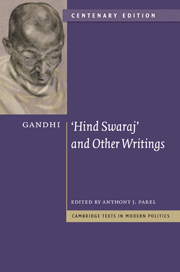Book contents
- Frontmatter
- Contents
- Preface to the centenary edition
- Acknowledgements
- Editor's introduction to the centenary edition
- Editor's introduction to the 1997 edition
- A note on the history of the text
- Principal events in Gandhi's life
- Biographical synopses
- Guide to further reading
- Glossary and abbreviations
- HIND SWARAJ
- Contents
- Preface to the English translation
- Foreword
- I The Congress and its officials
- II The Partition of Bengal
- III Discontent and unrest
- IV What is Swaraj?
- V The condition of England
- VI Civilisation
- VII Why was India lost?
- VIII The condition of India
- IX The condition of India (cont.): railways
- X The condition of India (cont.): the Hindus and the Mahomedans
- XI The condition of India (cont.): lawyers
- XII The condition of India (cont.): doctors
- XIII What is true civilisation?
- XIV How can India become free?
- XV Italy and India
- XVI Brute force
- XVII Passive resistance
- XVIII Education
- XIX Machinery
- XX Conclusion
- I APPENDICES
- SUPPLEMENTARY WRITINGS
- Bibliography
- Index
XV - Italy and India
Published online by Cambridge University Press: 05 October 2014
- Frontmatter
- Contents
- Preface to the centenary edition
- Acknowledgements
- Editor's introduction to the centenary edition
- Editor's introduction to the 1997 edition
- A note on the history of the text
- Principal events in Gandhi's life
- Biographical synopses
- Guide to further reading
- Glossary and abbreviations
- HIND SWARAJ
- Contents
- Preface to the English translation
- Foreword
- I The Congress and its officials
- II The Partition of Bengal
- III Discontent and unrest
- IV What is Swaraj?
- V The condition of England
- VI Civilisation
- VII Why was India lost?
- VIII The condition of India
- IX The condition of India (cont.): railways
- X The condition of India (cont.): the Hindus and the Mahomedans
- XI The condition of India (cont.): lawyers
- XII The condition of India (cont.): doctors
- XIII What is true civilisation?
- XIV How can India become free?
- XV Italy and India
- XVI Brute force
- XVII Passive resistance
- XVIII Education
- XIX Machinery
- XX Conclusion
- I APPENDICES
- SUPPLEMENTARY WRITINGS
- Bibliography
- Index
Summary
editor: It is well that you have instanced Italy. Mazzini was a great and good man; Garibaldi was a great warrior. Both are adorable; from their lives we can learn much. But the condition of Italy was different from that of India. In the first instance, the difference between Mazzini and Garibaldi is worth noting. Mazzini's ambition was not, and has not yet been, realised regarding Italy. Mazzini has shown in his writings on the duty of man that every man must learn how to rule himself. This has not happened in Italy. Garibaldi did not hold this view of Mazzini's. Garibaldi gave, and every Italian took, arms. Italy and Austria had the same civilisation; they were cousins in this respect. It was a matter of tit for tat. Garibaldi simply wanted Italy to be free from the Austrian yoke. The machinations of Minister Cavour disgrace that portion of the history of Italy. And what has been the result? If you believe that, because Italians rule Italy, the Italian nation is happy, you are groping in darkness. Mazzini has shown conclusively that Italy did not become free. Victor Emanuel gave one meaning to the expression; Mazzini gave another. According to Emanuel, Cavour, and even Garibaldi, Italy meant the King of Italy and his henchmen. According to Mazzini, it meant the whole of the Italian people, that is, its agriculturists. Emanuel was only its servant. The Italy of Mazzini still remains in a state of slavery.
- Type
- Chapter
- Information
- Gandhi: 'Hind Swaraj' and Other Writings , pp. 73 - 76Publisher: Cambridge University PressPrint publication year: 2009



